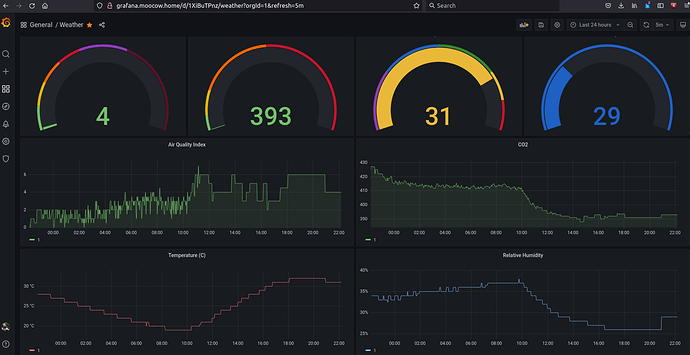Ah actually I’ve had it working for about a week or so now - the way I wired it up isn’t particularly elegant at the moment as I just have some wires with female pin header ends plugged right into the pins on the Xbee which is attached to my 900Mhz antenna that is, in, taped to the wall  So not professional but was good enough to test. I have a proper adapter board for the Xbee I can use to wire something more reliable. I haven’t pondered how to keep everything together. Making a case for both the AirGradient and Xbee would be ideal but since it’s out of the way, I may just velcro the Xbee adapter to the AirGradient case and call it a day for now.
So not professional but was good enough to test. I have a proper adapter board for the Xbee I can use to wire something more reliable. I haven’t pondered how to keep everything together. Making a case for both the AirGradient and Xbee would be ideal but since it’s out of the way, I may just velcro the Xbee adapter to the AirGradient case and call it a day for now.
The code ends up being really really simple and I’d be happy to share what I have there! Xbee talks serial so I just ended up outputting the JSON string directly out to serial and then capture it in a Python program running on my NAS that has the Xbee receiver. Xbee is just wired up with 3 wires (3.3V, GND, TX).
Since I can’t use the display in the darkroom, I basically commented that and the Wifi stuff out. Kinda defeats the purpose of the nice microcontroller but it works for my needs.
It’s a bit of a shame Digi hasn’t made any effort to make their programmable Xbee’s Arduino compatible (as far as I’m aware anyway). I haven’t messed with those features basically at all as a result but I think they are plenty powerful to manage the suite of sensors of the AirGradient. Seeed might have some microcontrollers with a built in LORA radio? I know they’ve been offering LORA products so that might be something to look at perhaps for situations where Wifi won’t due. As mentioned I’m using Xbee because I already had them for other purposes. But if I was going to do something from scratch, I’m not sure they’re the best option. And that’s only if dealing with unreliable or no-Wifi. I would imagine a majority of folks using AirGradients won’t have this need. Even so, Xbee 900Mhz and LORA can get miles of range which is significant for remote monitoring.
Anyways as far as the results go, this part isn’t really new since it’s the data coming off the AirGradient sensors, but still I thought I would share some of my data for viewing. I was able to draw some pretty useful conclusions in a short period of time, which is great!
Basically, though the above doesn’t show it, I found the CO2 levels rise a lot more quickly in my darkroom than I expected when I have the door closed. First night they shot up to 2800. Next time I was in there, I made a concerted effort to open the door more often and these kept the levels under 1000.
A more permanent solution is darkroom louvers (light tight vents). But now that it’s getting warmer where I live, I’ll need to start running the air conditioner and want to see how that changes things. Since that pulls in fresh air (at least to some degree) I wanna see how that changes things. Opening the door means I can’t regulate the temperature nearly as well and that can matter for some applications.
Anyways the TLDR is that it’s working very well in there! I need to have a more permanent solution for the Xbee wiring as noted but otherwise it’s great! I do expect I will still get at least one more for the house (which I can use over Wifi - no need for the Xbee there).
 )
)